
GLENN LONEY'S SHOW NOTES
By Glenn Loney, May 30, 2004

| |
|
Caricature of Glenn Loney by Sam Norkin. |
|
Please click on "
* " to skip to each subject in this index:
On the Road & In the Air *
FOR NEW YORK THEATRE-WIRE.COM *
All Arts Critics Bid To LA 2005 Conference! *
San Francisco Opens Golden Gates *
For The American Theatre Critics! *
Seeing Bay Area Shows: *
BEACH BLANKET BABYLON's 30th Anniversary! *
Constance Congden's Farcical A Mother at ACT: *
Other Theatre Adventures: *
Below the Bay on BART: *
Do You Know the Way To San Jose? *
SHAKEPEARE & COMPANY! *
Smokeless Pittsburgh Welcomes *
The North American Music Critics! *
But Only as Part of a Performing Arts Horde! *
Music Panels at the Omni William Penn: *
Meeting Sister Helen Prejean/ *
Seeing & Hearing Dead Man Walking! *
Saluting the Opera America Conference *
With a New American Opera! *
Singing James Baldwin at CAPA: *
Dancing Bach's Magnificat *
To Salute the Chorus America Conference! *
Sir James Galway & His Golden Flute *
Salute the 59th Conference *
Of the American Symphony Orchestra League! *
Signing Off with Bobby McFerrin! *
Will the Aging Audience Die Out? *
Mary Stuart Loses Her Head Once Again: *
There is Also Live Theatre in Pittsburgh! *
Ashland Unveils New Bardic Stagings *
And Other Treats at Oregon Shakespeare Festival! *
Three Parts of Henry VI: *
Priming the Powder of the Shakespeare Canon~ *
Nostalgia-Time During the Endless War on Terror! *
Other Entertainments *
Back Home in New York City! *
Re-Seeing Sight Unseen: *
Black PR Plunges into Darkest Brooklyn! *
Another Letter-Play? *
GLENN LONEY'S SHOW NOTES 2004.07us
By Glenn Loney
July 4, 2004
©Glenn Loney, 2004
ON THE ROAD & IN THE AIR
FOR NEW YORK THEATRE-WIRE.COM
June just has to be Survey Month. Or Overview Overkill…
Because your Roving Reporter has for years been writing and reviewing for such publications as Dance Magazine, Opera News, Theatre Arts, Theatre Crafts, Musical America, After Dark, Theatre Design & Technology, Performing Arts Journal, Other Stages, Western European Stages, New Theatre Quarterly, Educational Theatre Journal, & Entertainment Design, he has over time become a member of The American Theatre Critics Association, The Music Critics of North America, & The Dance Critics Association.
Not to overlook journalism and reviewing for The Christian Science Monitor, The New York Herald-Tribune, The Los Angeles Times, The New York Times, and many other newspapers & journals—which also included reports on Arts, Design, & Architecture, as well as Performance. In addition, for over a decade, your scribe edited, wrote, and illustrated ART DECO NEWS, which he later transformed into THE MODERNIST. This will soon be on-line for Modernists and Deco Enthusiasts.
Every summer, the three major performance critics' associations choose different American cities as sites for their annual conferences. This gives reviewers from all over the United States & Canada the occasion to savor what is being produced elsewhere. As well as the opportunity for Networking in a shrinking market for critics of the arts.
As I am always covering major European Festivals in July and August, I usually miss the Music and Dance Critics' American Conferences. Fortunately, the Theatre Critics have to meet before local theatre-seasons come to a summer closure.
In 2004, however, all three organizations met in June. The Dance Critics met in Philadelphia, at the same time the Theatre Critics were meeting in San Francisco. My first allegiance—as a longtime Professor of Theatre—has to be to the Drama, so off I flew to the City That Waits To Die—as that TV documentary called SF. Fortunately, the Drama mavens had already done a thorough conference-study of Philadelphia several seasons ago.
After viewing Bay Area Theatre, I flew back to Manhattan to change linen and then to fly off to Pittsburgh for the American Music Critics' Conference. Then back again to New York—with no time to write—and off to the Oregon Shakespeare Festival in Ashland.
All this with a savage, throbbing pain in my entire jaw, which resulted in Root Canal on my return from Oregon! This on-going pain may have affected the perceptions noted below.
All Arts Critics Bid To LA 2005 Conference!
Next summer, in 2005, my conference-attendance problems will be greatly simplified. All three of my critics' organizations—plus The International Association of Art Critics/USA—are joining forces for the first National Critics Conference in Los Angeles, from May 25-28!
Michael Barnes, Past President of the Theatre Critics, has been the spark-plug to ignite this initiative. As a multi-faceted arts-critic—and now Arts Editor—in Austin, TX, Barnes has long championed the concept of journalist-critics who have the backgrounds and skills to write about all the arts. This is especially important at a time when print-space for reviews and culture features is shrinking. And more newspapers are dying…
Titled CRITICAL UNITY IN CRITICAL TIMES: A National Symposium for Critics, the Los Angeles conference will be jointly sponsored by the USC's Annenberg School for Communications and the four critics' associations. It is to be held at the Omni Los Angeles Hotel at California Plaza, adjacent to the LA Music Center, the Mark Taper Theatre, and the Walt Disney Concert Hall.
Not only will the conference register arts critics & journalists from all over the United States, but editors, scholars, & educators will also be welcomed. More than 400 official participants are expected. Even the General Public will be able to attend some of the panels & symposia! [For additional information, contact Geoffrey Baum in Los Angeles at 213-821-1491.]
 |
| SF
ORPHEUM HOSTS LION KING. Photo: ©Glenn Loney/INFOTOGRAPHY 2004. |
San Francisco Opens Golden Gates
For The American Theatre Critics!
If San Francisco's neo-gothic Anglican Grace Cathedral doesn't have quarters for the Archbishop of Canterbury when he visits the Bay Area, His Eminence could always stay where the American Theatre Critics recently lodged: The Canterbury Hotel on Sutter!
Not only does the charming old hostelry feature murals of Chaucer's Canterbury Pilgrims, but it also has a Gothic Episcopal Throne—worthy of the Archbishop—in the breakfast-room. The hotel also provided a venue for meetings and symposia, as did various Bay Area theatres.
To celebrate its 30th Anniversary, ATCA launched Under the Copper Beach, a series of interviews with founding critics of the organization. This is edited by Past President Jeffrey L. Jenkins, Editor of the Best Plays series.
The tree in question no longer exists, but it was once an arboreal icon of the O'Neill Center in Waterford, CT, where every summer ATCA sponsors training seminars for acting and future theatre-critics. The late Ernie Schier once invited your scribe to give a lecture on a "general cultural subject" for the astounded enrollees. This was so long ago that I cannot recall the actual topic. I think it may have been the Concept of Time—which is certainly general enough.
In addition to our provocative panels, ATCA members were entertained by fellow-critic Mischa Berson's personal survey of a Life as a Theatre Critic. This is an annual High Point of the Conferences. Even Frank Rich has "shared." Berson began life as a critic in San Francisco, but is now chief theatre critic for the Seattle Times.
The Lorraine Hansberry Theatre was between shows when it hosted ATCA. It had just finished a successful run of August Wilson's King Hedley II. The elegant set-framework for its forthcoming Eubie! was in place on stage.
What would African-American theatre groups do without the Works of Wilson? Of course, there's always Susan-Lori Parks, but Lynn Nottage is the playwright to watch!
A Word to the Wise: Do not let Regina Taylor leave her DOA Drowning Crow on your doorstep!
The Hansberry's Artistic Director, Stanley E. Williams, and Quentin Easter, the Exec Director, made a point about being the only Ethnic Theatre around. But there cetainly have been Chicano and Pan-Asian productions in the Bay Area. And such groups are still alive and well in Southern California. Luiz Valdez, of the Teatre Campesino, has even been having Equity Problems.
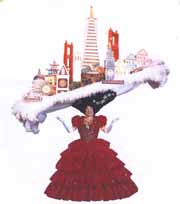 |
| BEACH BLANKET BABYLON CELEBRATES ITS 30th--Val Diamond in the San Francisco Hat! |
BEACH BLANKET BABYLON's 30th Anniversary!
Devised by the late, great Steve Silver, Beach Blanket Babylon has become a San Francisco Institution. After the lip-synching and long-vanished Cockettes—Cross-Dressers who were naked from the waist down—Silver's stars graduated to actually singing the lyrics, accompanied by a lively combo.
The Signature Feature of BBB is the fantastic and often overpowering headgear of the cast. Both beloved and noxious National Celebrities are lampooned, as are local personalities and events. Think: Donald Trump, Paris Hilton, Hillary, Gov. Arnold, Martha Stewart, et al. Each new prodution of this show closes with a more astounding San Francisco Hat. In this new staging, Val Diamond is dwarfed by her immense ostrich-trimmed brim, loaded with colorful models of SF Landmarks.
For a special SF Opera Benefit—which ATCA members saw in preview—the Hat was almost upstaged by the appearance of Frederica von Stade. Known for her "breeches-roles," she was seen first as Mario Cavaradossi. Her velcroed male-attire was snatched-off by wires, to reveal this popular soprano as Floria Tosca!
Opera-production is a costly undertaking, so Superman flew to the rescue shortly after Von Stade's turn. When the mild-mannered Clark Kent revealed His True Self, he turned out to be none other than George Schultz, former US Secretary of State & Bechtel Honcho. [Think Halliburton and no-bid contracts!]
Constance Congden's Farcical A Mother at ACT:
When the late Bill Ball brought his ACT ensemble to San Francisco, he produced no less than 36 shows in the first season. A number of them were directed by him as well. To show what the ACT—or American Conservatory Theatre—could create for its new hometown, all 36 of the productions were shown seriatim in its three theatre-venues in the season's closing week.
That was the ACT's high point. The downward descent has taken decades. The recent premiere of A Mother suggested the ACT is reaching the bottom of the well. This was embarrassingly ill-conceived and executed at the Geary Theatre. Especially with national critics on hand. It could pass muster with ACT subscribers, who no longer seem to have the cultural acuity to recognise expensively-staged community-theatre quality.
Actually, the plot and characters are not Congden's. They belong to Maxim Gorky, who drafted the play as Vassa Zhelesnova early in the last century. As with Gorky's Enemies and Summer People, there is a satirical Chekhovian undertone. But Gorky's indictment of the scheming, vulgar, greedy parvenues who replaced the Old Aristocracy is not the stuff of farce.
Farce, unfortunately, is what both Congden and director Carey Perloff had in mind. The ponderous upstage doorway doesn't lend itself to farce either. Maybe there should have been many more doors, only smaller? Gorky's characters are both greedy and vulgar, but they needn't be portrayed as buffoons and villains.
Staging farce does require some smart visual tricks, but it helps if the actors are able to play their parts with total seriousness. Director Perloff is not an adept of farce-antics, however, so audiences are offered repeated full-stage-crosses of an agitated servant for unearned comic-effect. Other players are effortfully comical.
As for Seriousness, Olympia Dukakis is still playing her recent Manhattan Clytemnestra. This doesn't work in farce, but even as the Matriarch, Vassa Petrovna—fiercely determined to prevent her late husband's estate from falling into the Wrong Hands—the Tragic Mode doesn't suit what should have been something more like Naturalism. That is, had Perloff & Congden left Gorky's script alone.
A theatre-dividend of sorts is provided by the presence in the cast of Dukakis' husband, the actor Louis Zorich. He plays her scheming Estate Manager. They are often cast together in shows. It may be a kind of Package-Deal. But a Lunt-Fontanne duo they are not.
I still cannot believe the talented stage-designer Ralph Funicello could be responsible for the ponderous, puzzling setting. It in no way served the play—either Gorky's or Congden's.
At San Francisco's prestigiously experimental Magic Theatre in Fort Mason, Stephen Belber's new drama, Drifting Elegant, offered a four-hander that is sure to be more widely seen. Its anti-hero is a latter-day Jimmy Porter, for whom nothing seems to work out. He's fueled by rage, but it's largely his own fault. There are also racial issues, notably Afro-American and Muslim. Not to overlook how a convicted rapist can re-enter society. Director Amy Glazer elicited very powerful and persuasive performances from Darren Bridgertt, Harry Dillon, Michael Gene Sullivan, and Barbara Pitts.
As for the playwriting talents of the astonishing and totally celebrated David Eggers—staggeringly admired author of A Heartbreaking Work of Staggering Genius—perhaps the elemental impact of the World Premiere of Sacrament! was somewhat vitiated by Eggers' collaboration with Campo Santo and director Kent Nicholson?
Nonetheless, this is another show that is sure to have a wider, longer life. It was, however, more interesting visually than textually. Campo Santo literally means Cemetery—not that this show should be interred—but it also means Holy Ground. So tread with care and do not walk of the graves! This work was performed at Intersection, a very intimate SF theatre-space.
Across the Bay at the Berkeley Rep, the production was a revival of Terrence McNalley's Master Class, starring Rita Moreno—who now actually lives in Berkeley! Guided by director Moisés—Laramie Project—Kaufman, Rivera was mercurial and magisterial. The Young Hopefuls were suitably scared, inadequate, clueless, brash, or fiercely determined to triumph. A cast-discussion followed, which Moreno dominated.
What was especially surprising to me—not having been out to see Bay Area shows for some five years—was Berkeley Rep's new Roda Theatre. Initially, when founded by Michael Liebert way back in 1968, its premises and productions were modest, but always challenging. Eventually, it graduated to a thrust-stage with amphitheatre-seating—which it still uses to good effect.
Under Artistic Director Tony Taccone, the Roda is something else! Conformed like a slightly smaller Broadway theatre—complete with fly-gallery and many lines for sending scenery aloft—it moves away from the hoped-for future of innovative, even bare-bones, theatre-productions. Is this an architectural Retreat Into Theatre History? Chicago's innovative Steppenwolf Theatre now seems also attracted to excess Theatre Technolgy…
Surely this should not be the case for Berkeley's Tony-winning Regional Theatre—which has produced Tony Kushner's Angels in America and the stage-adaptation of Maxine Hong Kingston's The Woman Warrior, among other impressive theatre-adventures.
There was no time to sample a production at the neighboring Aurora Theatre, also on Addison, just off Shattuck Avenue and the BART Berkeley station. But production-photos in their brochure suggest work of handsome quality.
Coming Aurora Attractions: Ellen McLaughlin's The Persians, after Aeschuylus, Jane Austen's Emma, adapted by Michael Fry, Joe Penhall's Blue/Orange, Conor McPherson's Dublin Carol, Carol Wolf's The Thousandth Night, and The Play of Daniel. This seems yet another example of new theatres creating audiences, which, in turn, make possible the creation of even more theatre-ensembles & productions.
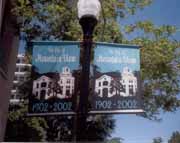 |
| MOUNTAIN
VIEW--Home of Musicals in Development. Photo: ©Glenn Loney/INFOTOGRAPHY 2004. |
Do You Know the Way To San Jose?
When I was a theatre grad student at Stanford University, Mountain View was a tiny Peninsula town on the way to San Jose. Google and Silicon Valley have changed all that. Mountain View now boasts a City Center with a theatre-complex as imposing as its matching City Hall.
And its TheatreWorks ensemble has been called "the best repertory theatre in the Bay Area." It certainly has the funding and the facilities to produce wonders. Its coming season will feature Arcadia, Red, A Little Princess, Living Out, Striking 12, Crowns, Shakespeare in Hollywood, & Vincent in Brixton.
ACTA members were too late to have seen its recent World Premiere of Willa Cather's My Antonia, with music by Stephen Schwartz, of Wicked. And also too late for the rest of its New Works Festival.
Under Robert Kelley's artistic direction, TheatreWorks has racked up some 47 world premieres and 105 regional premieres. What fascinated ATCA members was the ensembles' interest in developing new works of Musical Theatre. Some, like Little Princess—from which critics heard numbers performed by the creators—are eventually premiered in Mountain View, but others may debut on major metropolitan stages, East & West. ATCA critics heard excerpts—not for review—from several new musical projects being developed without the pressures of commercial theatre.
 |
| POST-MODERNIST
SAN JOSE REPERTORY THEATRE. Photo: ©Glenn Loney/INFOTOGRAPHY 2004. |
Down the road a piece is once sleepy San Jose, now transformed by the Magic of Digital and Dot. Com. There's even an immense new Fairmont Hotel, partly owned by one of those Saudi Princes—who is also a generous patron of the San Jose Repertory Theatre. The ensemble is very much at home in an astonishingly Post-Modernist theatre-complex.
The Rep's manic and highly stylish production of Theresa Rebeck's Bad Dates was wryly hilarious and a visual treat as well. Carol Halstead was marvelous as the dating-desperate & wardrobe-challenged Haley Walker. Robert Mark Morgan's ingenious set-design included a forestage bordered with elegant shoes. Glued-down to prevent spectators from filching or trying them on.
This was staged by Ms. Timothy Near, the artistic director, who was also host at a rooftop dinner for the critics. I told her about Aladeen—shown recently at BAM—dealing with Outsourcing To India. This is a real threat to Silicon Valley, which is San Jose's Lifeblood now. Ms. Near has just written me that she's in contact with the innovative group that created Aladeen. So something even more potent may be on the way!
Some ATCA critics opted for The Comedy of Errors at the California Shakespeare Theatre in Orinda. Having seen some of their productions, I chose David Eggers instead. By now, I should be Shakespeared-Out. One summer long ago I went to every Shakespeare Festival in the United States and Canada!
This provided content for an entire issue of Theatre Crafts! With enough left over for a book that was called THE SHAKESPEARE COMPLEX, Drama Books, but now out of print—
We were much too early for Shakespeare Santa Cruz, at the University of California at Santa Cruz. It promised in July & August Taming of the Shrew, John Fletchers's The Tamer Tamed, Aristophanes' Lysistrata, and Albee's Who's Afraid of Virginia Woolf? A Shewish Program Theme, if ever there was one!
Beginning in July, there will be no less than eight California Shakespeare Festivals on view, usually through August. Among them: Lake Tahoe Shakespeare Festival, Carmel Shakespeare Festival, San Francisco Shakespeare Festival, Marin Shakespeare Festival, Sebastopol Summer Shakespeare Festival, & Shakespeare at Stinson, which is a beach in Marin County.
The North American Music Critics!
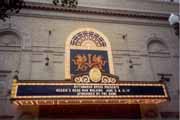 |
| DEAD
MAN WALKING--Pittsburgh
Premiere Marquee. Photo: ©Glenn Loney/INFOTOGRAPHY 2004. |
But Only as Part of a Performing Arts Horde!
The Main Performance Event in Pittsburgh this June was the local premiere of Jake Heggie's opera, Dead Man Walking, at the Benedum Center. It was the centerpiece of a week-long panorama of Pittsburg's cultural riches, organized primarily for arts ensembles, artistic directors, fund-raisers, performance-managers, and production-experts.
Presented as the First National Performing Arts Convention, its title was provocative: Taking the Arts to the Next Stage. Considering the current economic plight of many American cities and resultant arts-subsidy cut-backs, the title also seemed unduly optimistic. The Bush Administration has certainly been no friend to the Arts.
 |
| JAKE
HEGGIE--Composer of Dead Man Walking. Photo: ©Glenn Loney/INFOTOGRAPHY 2004. |
Leaders of America's symphonies, choruses, dance-troupes, opera-companies, and the North American Music Critics were all on hand to discuss shared problems and prospects in difficult times for The Arts. Curiously, there was no Theatre Component involved. Perhaps they were all tired out from the previous week in San Francisco?
The week of performances, panels, seminars, and discussions proved such a success, that it's hoped Pittsburgh will be able to repeat this initiative four years hence. It does take a lot of planning—and funding. Calling this the first such National Convention indicates high hopes for more sessions.
It is cerainly possible that other American cities with a rich range of Performing Arts would want to organize future conventions, continuing the Pittsburgh Initiative. What an Annual Arts Showcase such meetings could become! And they could also include Theatre Companies. Even Art Museums & Galleries—especially those with Arts Events?
Music Panels at the Omni William Penn:
Music critics were treated to some very special panel-discussions, notably: Read All About It? Or Not? Classical Music Criticism in Today's Newspapers. The obvious problem for music critics is that weaker newspapers are dying. And the survivors have less and less interest in reviews of the High Arts, given their plebeian subscriber-bases and their Editors' own prejudices.
The statement of the discussion topic was itself a bit ambiguous: did it refer to "classical" examples of Music Criticism? Or to critiques of Classical Music? What about reviews of Music that is less than Classic?
Another interesting panel was The Future of the Symphony Orchestra in America. Despite occasional reports of the death of yet another city symphony, apparently orchestras are alive and well in many cities around the United States.
Seeing & Hearing Dead Man Walking!
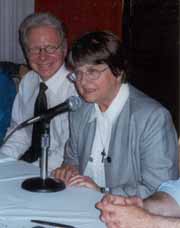 |
| SISTER
HELEN PREJEAN--With Dead Man Walking conductor, John Mauceri. Photo: ©Glenn Loney/INFOTOGRAPHY 2004. |
Of overwhelming interest, however, was the Music Critics' panel: An Opera with Legs: Dead Man Walking. Not only was the composer, Jake Heggie, on hand to describe his experiences in setting Terrence McNally's libretto to music, but conductor John Mauceri offered a brilliant explication of how and why the score functions so strongly in supporting the text.
The high point of the panel was the introduction of Sister Helen Prejean, CSJ, who is the central character in the opera. She discussed her experiences in helping men on Death Row to prepare for their earthly closures, as well as working with their distraught families and with the families of their victims.
 |
| SISTER
HELEN PREJEAN--Talking with an admirer at Dead Man Walking premiere.
Photo: ©Glenn Loney/INFOTOGRAPHY 2004. |
Sister Helen—who is a very impressive advocate for Abolition of the Death Penalty—is also almost a Force of Nature in her determination to make a difference in the lives of those who have done violence on others and on those who have suffered because of it. In the process, she has enlisted the aid of others, some of whom have directly suffered.
Jake Heggie's opera, she notes, is not her story as told in her book. Nor is it the substance of the film, Dead Man Walking, starring Sean Penn. Terrence McNally has created a new plot and new characters—not taken from life, but based on Sister Helen's experiences.
Soprano Kristine Jepson was eloquent in discussing her experiences in creating the role of Sister Helen, especially as she is centrally involved in the action during the entire opera. This is a taxing but ultimately very rewarding role, she affirmed.
Saluting the Opera America Conference
 |
| THEATRE
SQUARE--Heart of the Performing Arts in Pittsburgh. Photo: ©Glenn Loney/INFOTOGRAPHY 2004. |
Commissioned for the San Francisco Opera by then General Director Lotfi Mansouri, Heggie's opera was given a powerful premiere production at the War Memorial Opera House. But its stage is so large that the physical production could not be easily adapted to other American opera-stages of varying sizes and technologies.
As shown in Pittsburgh, Dead Man Walking is the same production shown last season at the New York City Opera. Having already been very impressed with the work itself and its realization on stage at Lincoln Center, I wondered how I would respond to a second-seeing.
If anything, the opera now seems even more powerful, more dramatic, more immediate, more relevant, finally, more shattering. Initally, the audience is shown a couple of naked teenagers having a fling in a convertible by a lake. Jazzy music pours from the car-radio.
Suddenly, two wild men are all over the boy and girl. The boy is shot. One of the men is about to rape the girl. She screams. He shoots her to keep her quiet. End of scene.
But it is now quite clear to the audience that two murders have been committed. This is essential dramaturgically, for they will soon see and hear the killer Joseph De Rocher—powerfully interpreted by John Packard—endlessly insist, even in letters and in person to Sister Helen Prejean, that he is innocent.
Never having ventured outside her sisterhood's work with problematic school-children, Sister Helen's Journey in the opera is an experience all the audience can share.
She is determined that Joseph shall finally confront the horror he has committed, acknowledge the terrible deed, and find forgiveness beyond this world, even if he cannot expect it from the families of his two victims. But this means she has to drive long distances to the state penitentiary and pass among rough guards and violent prisoners to reach Joseph. Police, guards, even the Warden, try to discourage her.
A point is made in McNally's libretto that the victims' families are angry that Sister Helen seems focused on Joseph and his devastated mother and brothers. She has no time for their pain and anger. Only at the close, does one of the fathers ask her to pray with him.
In the panel, Sister Helen acknowledged this fault of compassion. Now she and her associates make a point of reaching out to all involved in such tragedies. The Bottom Line is that neither Rage nor Vengeance is going to bring murdered victims back to life and to their loved-ones.
As noted in the panel, Dead Man Walking seems to be one modern opera with wide appeal, not least because Heggie has been able to tell the story in music with melodies and tunes. Even though it sounds almost Through-Composed.
The only musical element which seems less than compelling is the chorus of school-children—cast from local kids in the various cities in which the opera is performed—singing what's almost a Theme Song of the opera. This looks like Affirmative Action for Challenged Children on stage.
For the Record: Michael McGarty designed the impressively mobile setting of prison-towers, spiral-stairs, fences, grids, cells, and corridors—which are often in motion, flying in and out. Watch your head, Sister Helen! He even made sure the convertible had a Louisiana license-plate on it!
The effective lighting was designed by Brian Nason, with projections by Elaine McCarthy. Jess Goldstein's simple costumes were entirely appropriate.
Dead Man Walking is sure to have a longer life than many new operas. The production seen in Pittsburgh and in New York is also a co-production with Opera Pacific, Michigan Opera Theatre, Cincinnati Opera, Austin Lyric Opera, and the Baltimore Opera. Other regional opera companies will also surely want to schedule this powerful work.
Singing James Baldwin at CAPA:
Dead Man Walking will certainly have a longer life than Just Above My Head: A Jazzopera. This new work was premiered two evenings after Heggie's opera by the Opera Theatre of Pittsburgh. Not to be confused with the Pittsburgh Opera.
Composed by Nathan Davis, with a confusing libretto by Ursula Davis, this was shown on the limited stage of the CAPA Theatre—which belongs to what seems to be Pittsburgh's answer to the High School of the Performing Arts.
The most notable thing about this new work of musical theatre is that it is based on the novel by James Baldwin. The next most notable item is that Baldwin's incestuous memoire doesn't lend itself either to dramatization or to sung utterance.
The voices of the African-American cast were generally strong, even outstanding. But the acting skills were minimal, partly owing to the nature of the libretto. Nor was the production helped by danced mimesis, apparently intended to enhance the emotions and situations, such as they were.
 |
| HEINZ
HALL--Site of Bach Magnificat performances. Photo: ©Glenn Loney/INFOTOGRAPHY 2004. |
To Salute the Chorus America Conference!
The Pittsburgh Ballet Theatre had better luck dancing to the music of Johann Sebastian Bach, with the Pittsburgh Symphony Orchestra in the pit and the Mendelssohn Choir of Pittsburgh semi-circling the dancers.
Now that Bach's Mass in B-Minor—as well as various Passions, are deemed choreographable & danceable—the Magnificat certainly offers expansive musical-cues for dancers to magnify the Name of the Lord.
Some purists in the audience were annoyed at having a choral concert invaded by expressive movement. This event was, after all, the Opening Concert of the 27th Annual Chorus America Conference.
Most of the attentive spectators seemed delighted by the melding of choral song and dance-movement. Salvatore
 |
| HEINZ
HALL--Lavish Lobby of Concert Hall. Photo: ©Glenn Loney/INFOTOGRAPHY 2004. |
Aiello's original choreography of the Magnificat for the North Carolina Dance Theatre was recreated on the Pittsburgh ensemble by Jerri Kumery & Tim Yeager.
Purists had to content themselves with dance-free choral performances of Samuel Barber's Agnus Dei, Giuseppe Verdi's Ave Maria, and Zoltán Kodály's Missa Brevis. A great night for Catholics and Anglicans!
Oddly enough, there was no choral work—religious or otherwise—by Felix Mendelssohn on the program, even though the featured choir bore his name.
Sir James Galway & His Golden Flute
Of the American Symphony Orchestra League!
One has to regard with total amazement the planning that must have gone into bringing so many major American Arts Organizations together for this Pittsburgh Week of High Culture. Not only designing the profusion of panels & discussions relating to specific kinds of arts in performance, but also the programming of major evenings of performances saluting Opera Companies, American Choirs, Dance Ensembles, & City Symphonies.
[But why were the many Regional Resident Theatre Companies ignored?]
The Pittsburgh Symphony Orchestra—conducted with great athleticism and verve by Yan Pascal Tortelier—featured Sir James Galway and his Golden Flute in David Amram's Giants of the Night.
Its three movements celebrated Charlie Parker, Jack Kerouac, and Dizzy Gillespie. This was interesting, but Amram hasn't quite caught the Essence of his Idols. At the curtain-call, he came forward, laden with enough Hippie necklaces to recall the wretched excesses of the late 1960s.
Sir James seemed even more pixie-ish in performance than in his audio-interviews on WQXR, New York's "Good Music Station." His eyes glinted mischievously in certain passages. He seemed anxious for the audience to know how much he was enjoying playing for them…
Perhaps all that gold in the flute is getting heavy? His attack at times seemed unduly breathy. And the Good Life is showing in his mid-section. An ornamented yellow weskit unfortunately served to emphasize the midrif, rather than to conceal it.
The big ovation of the evening was reserved for the intricately, noisily percussive score of Joan Tower's thundering Tambor. Ms. Tower was not wearing Hippie necklaces.
The concert concluded with a sensuous reading of Debussy's Prélude à l'après-midi d'un faune and an especially rambunctious Strauss suite from Der Rosenkavalier, in which conducter Tortelier outdid himself in responding bodily to the swelling Straussian melodies.
Signing Off with Bobby McFerrin!
After an entire week crammed with conferences and performances, the various events and synergies were summed up at the close by the remarkable vocalist/musician/conductor/innovator/music-educator Bobby McFerrin and an agile ensemble. Pittsburgh had done itself proud!
With a four-octave range and ten Grammys, McFerrin is also a wonder to behold in performance. CDs of his Sacred Music Series were readily available, including 23rd psalm, grace, the garden, knickknack, & don't worry, be happy.
This late afternoon production followed a Saturday filled with Cross-Disciplinary Sessions for artists, arts administrators, trustees, and volunteers. These presentations & discussions focused on nine imporant arts-areas: Audience Development, New Business Models, Arts Journalism & Criticism, Diversity, Education, Governance, New Works, Public Policy & Advocacy, and Research.
As Senior Correspondent for New York Theatre-Wire.com and New York Museums.com, I was especially interested in the panels on The Arts Expericne On-Line and Distributing the Arts On-Line: Wave of the Future or Promise Unfulfilled?
It's to be hoped that the content of the almost forty sessions will be made available, either on-line or in print. You could check out the website: www.performingartsconvention.org…
Among other session-topics, a sampling includes:
•Art in a Changing World: Does Relevance Matter?
•Framing Policy: The Need for Info & The Risk of Unintended Consequences.
•What You Need To Know About Government Support.
•Top Priorities for Artists.
•Making the Democratic Process Work for You.
•High Art vs. Low Art: How False Dichotomies Are Affecting Art in America.
•Engaging the Public in New Work.
•What the Funders Are Saying.
•The Arts as Catalyst for Urban Development.
•The Anatomy of Buzz.
•Criticism & Journalism: The Next Generation.
•The New Ethics Environment.
Will the Aging Audience Die Out?
Frequently noted in various discussions was the preponderance of gray-haired people in arts-audiences. Some feared that arts ensembles might themselves die out after the Golden Agers pass on.
Fortunately, that has been proven a faulty analysis of audience-problems. For the past fifty years, critics and arts administrators have been worried about all those old people out front.
In fact, these graying audiences replace themselves regularly.
A lady-critic next to me jotted this note: "High correlation between attendance at arts events and teenagers at home."
She didn't get it quite right. What the statistical expert actually said was that adults with small children—and even with teenagers—tend to stay at home and spend their extra cash on family needs.
But, as soon as the birdies are out of the nest, the parents are subscribing to opera, dance, and music concerts. And, by that time, they often have gray hairs!
In fact, a Tidal Wave of new gray-haired audiences is predicted once the Baby Boomers are free to spend on themselves, rather than their kids' college educations!
Mary Stuart Loses Her Head Once Again:
 |
| MARY
STUART DIED HERE--Pittsgburgh's O'Reilly Theatre. Photo: ©Glenn Loney/INFOTOGRAPHY 2004. |
There is Also Live Theatre in Pittsburgh!
Even though Not-for-Profit Regional Theatres were not invited to the Pittsburgh Conference & Culture-Week, there was live theatre on view. At the O'Reilly Theatre—just across from Heinz Hall and down the street from the Benedum Center—the Pittsburgh Public Theatre was presenting an impressive if elemental production of Friedrich Schillers' powerful tragedy, Mary Stuart.
Directed by Ted Pappas, Lisa Harrow and Deirdre Madigan magisterially played the two cousin-queens, Elizabeth Tudor of England and Mary Stuart of Scotland. The large cast—handsomely costumed by Paul Tazewell, performing in a unit-set by James Noone—ranged from adequate to good to excellent.
But what made this production so impressive was once again the brilliance of Schiller's conception and his vision of the duelling monarchs: the one a virtually helpless prisoner, waiting for death; the other, fierce and powerful, but fearful of the legitimacy of Mary and her hold on the People.
 |
| "PHOTOPLAYS"
IN PITTSBURGH--Transformed into an Opera House. Photo: ©Glenn Loney/INFOTOGRAPHY 2004. |
Schiller's most telling stroke of dramaturgy was confronting the two queens in a castle park when Elizabeth is out hunting. This never happened: they never met. But the encounter seems dramtically right. If not historically…
[In Vivat! Vivat, Regina!, playwright Robert Bolt refused to alter history, but he did show them both on stage at the same time. But on two levels: Mary, above, in Edinburgh, writing to Elizabeth, down below in London. When their powers were reversed, Elizabeth was above on her throne, Mary, below, doomed in prison.]
Joseph Mellish's very playable translation preserved the eloquence of Schiller's original vision. It was such a pleasure to witness a dramatic confrontation of characters of such power and complexity, made vivid in powerful, poetic language. Rather than in the tired, even vulgar, common-places of much contemporary theatre.
Ashland Unveils New Bardic Stagings
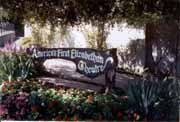 |
| FIRST
STAGE OF THE OREGON SHAKESPEARE FESTIVAL. Photo: ©Glenn Loney/INFOTOGRAPHY 2004. |
And Other Treats at Oregon Shakespeare Festival!
Once Upon a Time there was an American Shakespeare Festival in Stratford, CT, which challenged Canada's Stratford Shakespeare Festival and even, at times, Britain's Stratford Shakespeare Fest. Founded by the late John Houseman and Jack Landau, it gradually declined and died. Last Rites were performed by the last fest director, Michael Kahn.
But, all unknown to East-Coasters, there was another admirable Shakespeare Festival in the Far West, founded way back in 1935. No, it's not the San Diego Globe Shakespeare Fest: that doesn't have the track-record of Ashland's Oregon Shakespeare Festival, founded by the late Angus Bowmer.
For years, Ashland was the only Bardic fest to operate in the black, something unheard of in Not-for-Profit Theatres. Now, its productions receive handsome corporate sponsorships, as well as solid financial support from such patrons as Paul Allen, of Microsoft fame—for whom America's First Elizabethan Theatre is now named. Or at least the semi-covered amphitheatre-seating—if not the quasi-Tudor stage-facade—is now known as The Allen Pavilion. He has also loaned the Festival his own copy of the First Folio.
Unfortunately, it is not autographed by either William Shakespeare or Christopher Marlowe.
 |
| PAST,
PRESENT, & FUTURE SEASONS IN OSF'S ELIZABETHAN THEATRE. Photo: ©Glenn Loney/INFOTOGRAPHY 2004. |
Under the current artistic direction of Libby Appel, the Oregon fest has had its seasonal ups-and-downs, but it has certainly been more ambitious than any other American Shakespeare Festival. Although the open-air Elizabethan Theatre can only be played from June through October, in its other two playhouses—the Bowmer and the New Theatre—the season begins in February.
In the current season, King Lear, Much Ado, and Henry VI, Parts Two & Three, are being played in rotating rep in the Elizabethan Theatre. In the Bowmer, the Bard is represented by Comedy of Errors. Other shows include that actor-proof Barrymore-fest, The Royal Family, plus, Dürrenmatt's The Visit, Hansbury's Raisin in the Sun, and Frank Galati's Oedipus Complex.
In the New Theatre, Henry VI, Part One, subtitled Talbot & Joan, offers a useful French preface to the Wars of the Roses as they evolved on English soil. And, continuing Appel's dedication to introducing predominantly white Pacific Northwest audiences to the African-American Experiece on stage, Susan-Lori Parks' Broadway novelty, Topdog/Underdog, is also in rep. Along with the Brit play, Humble Boy, recently and mercifully briefly on view at the Manhattan Theatre Club.
The formerly Elizabethan-Themed Green Show—beloved mainly because it is free—has become increasingly divorced from Shakespeare or even Merrie Olde England. Once limited to period-songs, period-instruments, and period-dances, it now seems to strive for a United Nations of Cultural Experiences, plus Interpretive Dances.
Because of the real National Economic Difficulties afflicting many Americans—especially on the West Coast—many families are electing to stay at home rather than spend on costly vacations promising Cultural Fulfillent. Last summer's season began slowly but recovered later on.
This June, however, it was surprising and discouraging to see empty seats at premieres of the outdoor Shakespeare productions. And even inside for such a handsome and frenetic staging as Royal Family.
The dubious Democratisation of Iraq—already having cost billions & billions—may be blamed for some stay-at-homes, but color-coded Terrorist Alerts could also be keeping theatre-lovers close to their bunkers.
You never know where the Taliban will strike next: King Lear seems a likely target, for it deals with the unwise cutting-up of a kingdom into feuding parts! How about a trendy production of Lear, with Dick Cheney dividing up Iraq among Donald Rumsfeld, Paul Wolfowitz, and Condi Rice—as a Cordelia who cannot tell a lie?
 |
| KING
LEAR SETTING
FOR OREGON'S ELIZABETHAN THEATRE. Photo: ©Glenn Loney/INFOTOGRAPHY 2004. |
Actually, Ashland's King Lear—as staged by veteran actor-director James Edmondson—is fairly traditional, with Kenneth Albers very affecting as the aged, deluded, and irate monarch. If anything, Albers is much better than Christopher Plummer was recently at Lincoln Center.
Unlike the Lincoln Center Goneril and Regan—who even looked evil from their first moments on stage—Maya Thomas and Catherine Lynn Davis were properly & ritually royal—before they began their disastrous descent into demonic plots. Julia Oda's Cordelia had a certain emotional power, but her slight form made her seem less than a princess, more doll-like.
Robert Vincent Frank was a bitterly wise Fool, with Ray Porter as the stalwart Kent. Both the Edgar and the Edmund of Gregory Unnington and Jos Viramontes were fortunately better than their Lincoln Center counterparts.
Veteran-designer Marjorie Bradley Kellogg—I interviewed her years ago for Theatre Crafts—met the challenge of "differencing" the basic Elizabethan-Theatre façade with an unusual center-stage portal. It looked like a gigantic Firestone Tire, with an Aztec Temple doorway in its heart. As the kingdom broke apart, so did this great wheel, its segments moved to the outer margins of the stage. Susan Tsu's costumes were effectively semi-period—or quasi-archaic.
As for that other English Dynatic Drama in three installments, Henry VI, the decison to offer Part One as a Prelude in the New Theatre seemed to please a number of spectators who were unfamiliar both with the plays and the historical facts. Neither of which have all that much to do with each other…
Having experienced the Royal Shakespeare's Wars of the Roses from the front row of the Festival Theatre years ago in Stratford-Upon-Avon, nothing since has come anywhere near the power and panorama of that extended production.
Nonetheless, Libby Appel & Scott Kaiser's New Theatre stage-interpretation of Kaiser's adaptation of the dramatic materials was coherent and made sense of the multiple plot-complications.
What soon palled, however, was the constant rushing on and off of French and English armies, condemned as they were by William Bloodgood's two end-stage ramparts—with audiences divided on both sides of the central playing-corridor—to criss-cross this area in endless X-patterns.
Look where they come again! It must be the English: isn't that Talbot's Pennant? Or is it his Guerdon? Certainly it is his Device!
Tyler Layton was sympathetic as Joan La Pucelle, a witch to the English, but suggestively much more to Shakespeare. The ascetic-appearing Cristofer Jean made a sincerely pious but maddening monarch as Henry VI. Both the piety and the royal obtuseness deepened in the power-struggles of the second and third parts, which had the real advantage of the spacious Elizabethan stage.
Designer Bloodgood had more freedom with this arena, but he did link the decor with the wooden ramparts of the New Theatre staging, for continuity, if nothing else. Deborah Dryden's costumes in all three parts did much to aid in identification of the various warring factions. Robin Goodrin Nordli was especially effective and imperios as weak King Henry's dowerless but ruthless Queen Margaret.
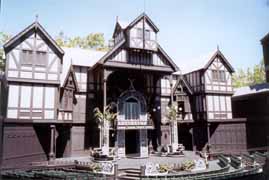 |
| SETTING
MUCH ADO ON ASHLAND'S ELIZABETHAN STAGE. Photo: ©Glenn Loney/INFOTOGRAPHY 2004. |
Priming the Powder of the Shakespeare Canon~
In Ashland's never-ending quest of completing the Shakespeare Canon in production once again, the company can breathe a sigh of heartfelt relief: Henry VI is out of the way for another decade!
That multi-talented and longtime Ashland architect/designer Richard L. Hay provided a real visual treat in differencing the Elizabethan Stage for Laird Williamson's production of Much Ado About Nothing. Wonderful Art Deco motifs were worked into a fanciful & flexible framework. And Elizabeth Novak's handsome costumes were even more colorful in dressing the stage.
As Beatrice, Robin Goodrin Nordli proved an excellent comic foil for the frenetic Benedick of Brent Harris. But this frantic actor may have more nervous-energy than is good for the characters he plays. Or even for the supporting ensemble. [In The Royal Family, his John Barrymore-type seems totally Over-the Top, to the point of unBarrymore-like falsetto in some utterances!]
Tyler Layton was a sweetly innocent and horribly wronged Hero. Jos Viramontes was a callow & callous Claudio. But then this age-old plot of a woman falsely accused of lechery is always problematic in performance. Franco Zeffirelli finessed it at the Old Vic for the fledgling National Theatre. But he also had Maggie Smith & Robert Stevens as his Beatrice & Benedick. In a decor suggesting an Italian Street-Fair.
At least Much Ado is easier to manage that All's Well, which also has a truly loving woman despised and rejected.
Director Bill Rauch and designer William Bloodgood outdid themselves in imagining The Comedy of Errors as taking place in Las Vegas/Ephesus, with Duke Solinus and his black-clad men as Soprano-like Mafiosi. This proved a continuously colorful and ever-changing visual concept.
With the pounding music of Todd Barton, the glitzy costumes of Joyce Kim Lee, the brilliant lighting of Robert Peterson, and the high-octane performances of Ray Porter & Christopoher DuVal as both sets of twins—the Antipholuses & the Dromios—this was such a frenetic production I nearly didn't make it to the hilarious close.
In terminal root-canal agony, I had just taken two pain-killers before the show. As it progressed, with each burst of stage-energy or revolving changes of sets & props, I grew more and more queasy.
I held it to the end and finally barfed in the lobby litter-bin, to the immense relief of the house-manager—who feared the worst for his carpets. This was the pain-killers mixing with luncheon salad and dill-pickles, nothing more.
No fault of the production, which clearly delighted the audience. But, had it been less colorful, less hectic, less super-charged, I probably would have digested both the dill and the drama.
Nostalgia-Time During the Endless War on Terror!
As for the Kaufman/Ferber Royal Family—which was recently shown in Chicago by no less an innovative ensemble than Steppenwolf Theatre—the success of the Ashland staging suggests that desperate times make audiences long for sentimental nostalgia. The hectic lifestyles of the Cavendish/Barrtymore Family provide plenty of onstage enery and excitement. But they are as nothing to the daily dramas in the headlines.
Is it time yet again for You Can't Take It With You, Three Men on a Horse, Room Service, and Life With Father?
With a lavishly-dressed and handsomely-structured duplex setting by Richard L. Hay, this Royal Family was a delight to behold and great fun to watch. But, as previously noted, Brent Harris was way over the top. Dee Maske was properly Matriarchal as Fanny Cavendish. Linda K. Morris and Judith-Marie Bergan were also admirable as Gwen and Julie Cavendish. The rest of the cast bustled about as if inertia were death.
Has Drew Barrymore ever seen this comedy? Could she ever have been a Julie?
Next season in Ashland, the Wars of the Roses continue with Richard III in the Bowmer. On the outdoor stage, Twelth Night, Love's Labour's Lost, and Marlowe's Tragical History of Doctor Faustus will rotate.
August Wilson's Ma Rainey's Black Bottom will be revived for the New Theatre, along with Octavio Solis's Gibralter, and Robert Schenkkan's new By the Waters of Babylon. This is the drama's "working-title," which may be changed as the same name has long ago won fame as a Stephen Vincent Benet tale of Manhattan after the Nuclear Holocaust. Benet imagined his tale long before there was such a thing as the Atomic Bomb. How could he have known?
The Bowmer will also have new productions of Cowley's The Belle's Strategem, De Filippo's Napoli Milionaria, Shaw's The Philanderer, and—you guessed it!—Room Service!
Before flying off to San Francisco, your scribe savored the 2004 Outer Critics Circle Awards at Sardi's, in the Eugenia Room. I was sitting near the kitchen, which was only fitting.
Not only was it close to the food, but, as Secretary of the OCC, I had done really nothing to ensure the success of the event, other than nominate and vote. The burden of tabulating the votes, inviting Presenters, notifying winners and their producers, and organizing & scripting the Awards as usual was in the capable hands of OCC's President, Marjorie Gunner. She was ably assisted by Patrick Hoffman of the Lincoln Center Library and by other diligent members of the Executive Committee.
Although the Outer Critics Circle also nominates Off-Broadway productions and talents, this year the awards largely honored Broadway, as did the Tonys, which are announced after the OCC Awards. Go Figure! Most of the really imaginative theatre was not produced on Broadway this season.
Among new & old plays seen before my departure for European Festivals were the Manhattan Theatre Club's revival of Donald Margulies' Sight Unseen at the new/old Biltmore. Laura Linney was interesting as the rejected Shiksa who once loved a conflicted young Jewish painter who has become a Jeff Koons-style Collectible Artist of little perceptible talent. Ben Shenkman made one wonder what she ever saw in him. Byron Jennings was the silently furious Brit archeologist she settled for. This play is believed by some to be Emblematic. But I'm not sure of what…
Black PR Plunges into Darkest Brooklyn!
Lynn Nottage's new play at Playwrights Horizons is nothing like her prize-winning drama, Intimate Apparel, at the Steinberg Center. That has disappointed some critics, but Fabulation, or, The Re-education of Undine shows Nottage is no slave to formulas. Nor is she a one-shot playwright.
Charlayne Woodard is dazzling, beautiful, and very hard-edged as the No-Prisoners-Taken publicist for newly rich African-Americans wanting to make a mark in Manhattan. She is, in short, a Black Lizzie Grubman, but with a lot more style.
Unfortunately, she is no judge of male character, for her Latin lover robs her blind and leaves her pregnant. Forced to return to her Black Brooklyn Roots—and the family she had dismissed at Dartmouth as killed in a fire—Undine hits rock-bottom. But it's actually rather amusing, including Dope Addicts' meetings she's ordered to attend after trying to score crack for her addicted Grandmother—who's told the family she has diabetes.
This is certainly NOT a version of The Lower Depths as a farce. In fact, Undine's family are all Security Guards, proud of their profession. And still ready to take in their erring kin, especially with a new baby on the way.
The once-promising John Robin Baitz is not keeping his promises. Also at Playwrights Horizons, the obsurely Futuristic Chinese Friends seemed both improbable in its elements and unnecessary in its agendas. Does Baitz have a Father Problem?
Jim Dale is one of my favorite performers—and he is on stage in New York far too seldom. So it was definitely a pleasure to experience his nuanced performance, reading letters, in Address Unknown at the Promenade.
As well as the performance of William Atherton, who does not seem to age.
Dale plays a San Francisco-based Jewish art-dealer. His German-born partner returns to Germany just as Hitler is coming to power. He becomes an ardent Nazi and fails to save his old friend's actress-sister—and his onetime lover—from a Death Squad.
Via unwanted letters, the San Francisco writer is able to destroy his former partner. This was surely powerful as a story way back in 1938, but there are other Monsters out there now.
When I saw director Frank Dunlop just after the performance, I suggested John Simon would dismiss the show as another Letter-Play. Frank groaned. In the event, Simon's review is titled "Going Postal," and his judgment is that the play "doesn't deliver."
[For the Record: Years ago, I edited the Young Vic Production-Book of the Frank Dunlop/Jim Dale Scapino. One of the actors in that show—seen in London, Edinburgh, at BAM and on Broadway—was young Phil Killian. This season a Phil Killian is a Directing Fellow at the Oregon Shakespeare Festival. Could it be his son? I should have asked…] [Loney]
Copyright Glenn Loney, 2004. No re-publication or broadcast use without proper credit of authorship. Suggested credit line: "Glenn Loney, New York Theatre Wire." Reproduction rights please contact: jslaff@nytheatre-wire.com.
| museums | NYTW mail | recordings | coupons | classified |